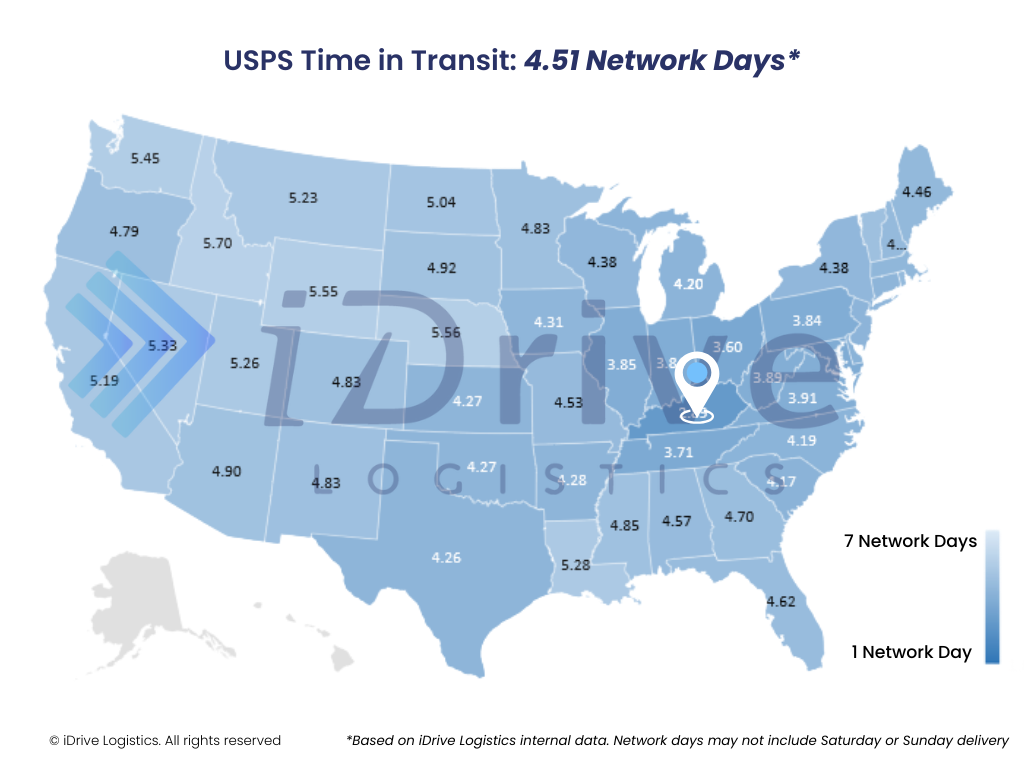USPS. FedEx. UPS. Amazon Shipping. DHL. OnTrac. GLS.
If you’ve shipped a package (or thousands), you’ve faced the question: Which carrier should I use?
With so many variables at play–package weight, delivery speed, distance, cost, and even customer expectations–there’s no one-size-fits-all answer. The good news? There’s absolutely a “best fit” for each scenario. You just need the data to find it.
At iDrive Logistics, shipping data is our bread and butter. Over the past few decades, our team has shipped tens of millions of parcels across every major carrier. We’ve worked with Carriers for optimal agreements, optimized routes, and built technology that analyzes millions of shipping data points in real time. This gives us a rare perspective into which carriers do and don’t deliver (literally and figuratively) in different situations. iDrive has worked hard to earn our reputation as a credible and experienced voice on the topic of Carrier selection, delivering measurable savings and operational improvements for our clients.
In this guide, we’ll share what observations about the best carriers for speed, cost, weight, and package size, along with some insider insights you won’t get from a rate card.
How to Choose the Right Carrier for Your Goals
Carrier selection goes beyond just a logistics decision. It’s a customer experience decision in that the wrong choice can cost you money and loyalty. To make it easier, let’s break this down into five common priorities: speed, savings, small packages, heavier shipments and localized delivery.
Note that the best carriers and their specializations shift, so it’s important to update your knowledge on the following regularly.
1. When Speed Is Everything
If your priority is getting a package from Point A to Point B as fast as humanly possible, two names usually rise to the top: FedEx and UPS.
Both offer premium Air services (FedEx Priority and Standard Overnight, 2 Day, Express Saver and UPS Next Day Air and Next Day Saver, 2 Day, 3 Day select) with guaranteed delivery times. These are ideal for time-sensitive shipments like medical supplies, legal documents, or last-minute gifts.
FedEx is historically known for air delivery and UPS for ground, however, both now offer very similar, and very reliable service, across all levels of service.
When it comes to Ground Services specifically, both FedEx and UPS are strong contenders for businesses that need consistent, reliable delivery. Both have sophisticated tracking systems and broad logistics networks that offer high levels of transparency and dependability.
2. When Cost Is King
If you’re trying to protect your shipping budget, USPS can be a great option for affordability, especially for packages under 20 lbs.
- USPS Ground Advantage and Priority Mail with options such as Cubic Pricing and Flat Rate offer some of the lowest nationwide rates for specific shipments under 20 pounds.
- Free packaging is offered in certain circumstances for many services.
- USPS delivers to every U.S. address (including PO boxes and rural locations) at no extra charge.
- Online postage tools and business accounts unlock additional discounts.
Another cost effective option includes Parcel Consolidators such as DHL eCommerce, ePost Global, OSM, UniUni and others. Consolidators are typically most cost competitive for lightweight shipments under 10 lbs. Time in transit averages a little longer than the major carriers but can be worth the trade off, especially for lower value eCommerce goods.
For businesses with enough volume, or those shipping regionally, Regional Carriers such as GLS, LSO, OnTrac, Spee-Dee Delivery and others can have lower rates than the national carriers for shipments within their territories. Regional Carriers are often overlooked, but for concentrated customer bases, they can deliver faster and cheaper.
Many businesses also combine USPS, Consolidators, Regional and National Carriers for different parts of their business. This blended approach keeps costs down without sacrificing speed, coverage, and customer satisfaction. If you do not have the volume to take such a targeted approach then looking at a 3PL for fulfillment can help lower shipping costs as an offset to having someone else do it for you with the added bonus of allowing you to concentrate on your business.
Pro tip: Don’t overlook Amazon Shipping when considering ground service, even if you’re not selling on Amazon. Amazon Shipping is relatively new as a ‘traditional” Carrier, but the ability to tap into the same delivery network built for their internal Prime customers can be a benefit to non-Amazon shippers. Amazon offers a ground service that can compete on delivery times, often at a lower cost to shippers located in areas where they have pick up services. Amazon Shipping can be a great cost-effective option for ground economy deliveries.

Source: https://www.idrivelogistics.com/blog/how-to-choose-a-shipping-carrier-with-maps/
The map above shows the average time in transit we have seen from Amazon Shipping, ground shipping, based on a Kentucky point of origin.
3. For Small, Lightweight Parcels
If your items weigh less than a pound, USPS Ground Advantage and Consolidators will typically be the best options. The best option for you will depend on balancing cost versus time in transit.
Other potentially cost-effective options are UPS SurePost and FedEx Ground Economy. SurePost and Ground Economy are services that are geared towards Residential shipments and are slightly slower than their regular Ground Residential and Home Delivery services. Shipments using SurePost and Ground Economy will normally be priced lower than the traditional services as well. This approach works well for businesses with high volumes that don’t need premium speed.
Pro tip: If you sell through marketplaces like Etsy, eBay, or Shopify, you can often access built-in USPS discounts to make small-package shipping even cheaper.

Source: https://www.idrivelogistics.com/blog/how-to-choose-a-shipping-carrier-with-maps/
The map above shows average shipping times for USPS Ground Advantage originating from Kentucky.
4. For Bulky, Heavier Shipments
When it comes to heavier (50 - 150 pounds) and / or oversized packages, UPS Ground and FedEx Ground are the workhorses of the industry. They handle furniture, gym equipment, industrial parts, and anything up to 150 pounds with ease. In addition, for shipments with multiple packages going to the same location on the same day, UPS Hundredweight (CWT) and FedEx Multiweight (MWT) are great options offering pricing based on total weight, rather than by each individual package, thereby reducing cost.
For shipments that exceed the limits of traditional parcel services, Less than Truckload (LTL) companies become the best option. Companies such as FedEx Freight, SAIA, Old Dominion and Others offer palletized shipping with services like liftgate delivery and scheduled appointments, which is critical when shipping to customers without loading docks.
5. For Highly Localized Deliveries
If your customers are concentrated in a specific region (ex. the West Coast, the Midwest, or the Northeast) Regional Carriers can be a game-changer.
Carriers like GLS, LSO, OnTrac, Spee-Dee Delivery and others specialize in short-haul shipping, often delivering within 1–2 days at rates that beat national carriers. They tend to operate smaller, denser networks, which allows them to move packages faster with fewer handoffs. That means:
- Shorter transit times for local shipments
- Lower shipping costs for regional deliveries
- Reduced risk of damage thanks to fewer touchpoints
These carriers can be especially valuable for:
- Retailers with regional fulfillment centers
- Subscription box companies shipping to the same customers each month
- Businesses in competitive local markets where next-day delivery is the norm
Pro tip: Regional carriers aren’t just cheaper. They can help you compete on speed without paying for expensive national expedited services. The key is matching your customer heat map to the carrier’s coverage area. If 70% of your orders go to California, Nevada, and Arizona, GLS or OnTrac might deserve more of your shipping volume than FedEx or UPS if you ship from a location within that same area.
The Bottom Line: Carrier Selection Is a Strategy
The most successful shippers rarely stick to one carrier. Instead, they build a carrier mix that matches each package profile to the best-fit service. The key is to know your shipping characteristics at the package level. Making choices based only on overall averages can end up hurting you in the long run.
Our data from tens of millions of shipments shows:
- Most shippers can benefit from a multiple Carrier approach, but only if they truly understand their Carrier Agreements, their package characteristics and how those two factors match up.
- USPS and Consolidators are great options for lower weight shipments
- FedEx and UPS lead on speed and reliability with multiple levels of service
- Amazon Shipping is a rising player for ground service depending on shipping location
- Regional carriers fill critical cost-saving gaps.
- The right 3PL can help take advantage of a multiple Carrier approach when the Shipper does not have to worry about meeting levels set in an agreement with a specific Carrier
By aligning carrier selection with your business priorities and revisiting that strategy regularly, you can lower costs, improve delivery reliability, and turn shipping into a competitive advantage.
In today’s market, delivery isn’t just a service. It’s a brand promise. Choose your carriers wisely.










